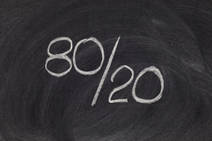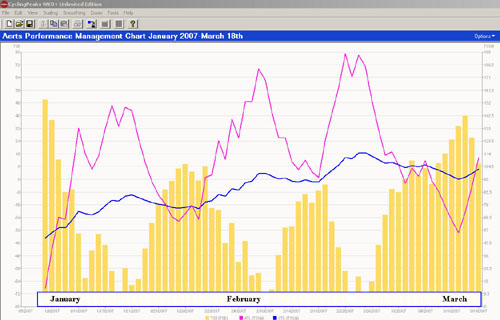
The New Year has arrived, and this is the perfect time to set new goals and targets. So why don’t you challenge yourself to improve your overall cycling skills and performance?
Here are ten failsafe ways to boost your performance in 2011.
1 – Take responsibility for your own training
Take the bull by the horns and be proactive. January 1 is a great time to start changing any bad habits. On the other hand, if you are a “reactive cyclist,” it’s time to change.
It’s always tempting to blame others when things don’t work out the way you want.
In these instances, you are being reactive, and that is simply a negative attitude that will hinder you from reaching your goals. Being proactive is about taking responsibility – don’t talk, just do it.
If you take responsibility, you will achieve a lot more success. In addition, being positive has several side effects. For example, it’s better to try to make your group rides attractive instead of complaining about why so few people join them. Make sense?
2 – Apply the 80/20 principle to your cycling training

I always like to use the analogy of the financial world. You invest in training time, and you get a substantial rate of return in cycling performance.
Italian economist Vilfredo Pareto made a rule about investments: the basic principle is to focus your effort on the 20% responsible for 80% of your results.
But how can you apply the 80/20 principle to your cycling training in 2011?
Well, take a look at your training in the past year. Think of the days that had the most positive impact on your future performance. Then, examine those days in detail. Why were they the best?
It is not difficult to highlight the most challenging workouts, but these are the most crucial to successful optimization regarding time effectiveness and successful training planning for 2011.
3 – Every ride should have a purpose
I always urge my riders to have a purpose with their training sessions. It is not just about interval days and race days. I want to make them stronger and better cyclists every day. If they’re on a recovery day, it’s an excellent opportunity to practice some technical skills, which do not require physical power.
You could, for example, improve your cornering and recovery in the same ride. Bin the junk miles and give every session a real focus.
4 – Sleep more
One of the healthiest things in life is to sleep well. But, unfortunately, most people don’t get enough sleep, and their health suffers.
For cyclists, lack of sleep will cause fatigue and affect performance. As a cyclist, sleeping is a crucial part of the recovery process. Try to get at least 7 to 8 hours of sleep each night.
5 – Eat better and time your post-exercise meal
Good nutrition is vital to performance and recovery.
When considering post-exercise nutrition, always have a recovery drink immediately after exercise. Then you should consume 1g of carbohydrate per kg and 1/3g protein per kg of body weight within 30 minutes of finishing moderate to high-intensity training sessions.
The post-exercise drink is vital and is an opportunity to use legal doping since you benefit from the insulin boost you get when you drink both carbohydrates and protein. Insulin is an anabolic hormone that helps you rebuild glycogen stores and muscles after training sessions.
If you don’t get energy immediately after exercise, then you maintain the catabolic status and delay the recovery process.
6 – Analyze your training sessions
Take some time to reflect. What did you achieve in 2010, and how did you achieve it? What were the highlights and downsides?
Analyzing your performance in the past 12 months will make your workouts even stronger in 2011.
If you have access to a power meter or heart rate monitor data, you should also spend some time analyzing the metrics from your key workouts, performance tests, and races in 2010.
7 – Include power meter training
Power meter training is a growing phenomenon. It’s easy to do and the single most effective way to monitor progress.
There is one significant reason I strongly recommend power meters: it makes it possible to precisely control the workload during interval training, ensuring that the right physiological skills get trained. If you don’t have a power meter, make it a priority to experiment with one during 2011.
8 – Prioritize high intensity intervals
There is no doubt in my mind that training with high intensity is the most time-effective way to improve your performance. Elite and professional riders need to train at (or very close to) VO2 max to make further progress.
When you give the highest priority to your interval training, it’s also much more likely to succeed.
Try to perform intervals as the most crucial part of your ride. Making interval training the most important thing will put it above achieving your planned distance, joining a social group ride, or even taking part in a race.
9 – Make your training as specific as possible
What are the decisive parts of a race that you are preparing for? A hill? A sprint finish? A basic rule of solid cycling training is to focus on what you aim for during a race.
If you make your training more specific, your body will receive the optimal physiological improvements for the particular event you have in mind. So, for example, if you want to take part in a hilly race, you should train on courses that have undulating profiles.
10 – Make your 2011 cycling training plan now
The fastest way to improve as a cyclist without working harder is by adding some structure to your training. Following and sticking to a training plan is a simple but effective approach, and it pays off quickly.
Riders often believe that they feel stronger because of the unique combination of intervals that I devise for them, but, to be honest, the more likely explanation is that they have some structure to their training program.
If you are a hard-working cyclist, you deserve to achieve the best possible results with the work you do.
You don’t (necessarily) have to train more or harder to achieve better results.
If you achieve the right structure with proper amounts of interval training on the good days, there is a good chance that you will improve quickly and continue doing so.
And the best part is that you won’t have to spend more time away from your family or friends to achieve this progress.
Suppose you haven’t got a training plan for 2011. In that case, you can try one of the accessible cycling training programs here on Training4cyclists.com or, even better, use the detailed 16-week training program included in my recently published e-book, Time Effective Cycling Training.
11 – Do the little extra it takes to succeed
Yes, I know this is supposed to be 10 Steps for Better Cycling Performance in 2011, but I’ve included point 11 to highlight that sometimes it can pay off to go the extra mile. Sometimes you have to dig a little deeper into your reserves when you train. The saying is “no pain, no gain,” and there’s no doubt a bit of suffering can go a long way if you want to beat the opposition.


This is just so motivating to read. If I can implement a few of these tips then I’m sure 2011 will be a great season for me. I will put my focus on #1, #3 and 5# and see what happens!
Hi You Happy New Year if possible a new training program put on the web. Thanks..
@Michael – That’s great – go for it!
@Amin – I plan to publish more training programs in 2011, but I am not completely sure about the concept. Happy new year to you too. 🙂
Jesper – I have your training guide and love your blog. I have a question about when I should incorporate the VO2 max training (14-day plan) into my off season training schedule. I am just heading into my first off season and trying to plan my winter training schedule to prepare for my second RR season starting in April. Should I do the VO2 max training before the 16-week plan or after or during? Appreciate your input!
Thanks,
Jane
Hi Jane,
I wouldn’t recommend the VO2 max booster program as a starter for your winter training program. Don’t go too hard when you start your winter season. Though, feel free to include some of the workouts once in a while throughout the winter season.
Hi Jesper!
It is obvious, that you and many others advocate for us cyclists to prioritize high intensity intervals, if we want to improve our performance. “Bike less but harder and you will be successful” is the “mantra”.
But what about us, who wants to peak once or twice in f.ex. long mountain competitions like La Marmotte?
If you are out there in 7-8 hours, it will not be enough to do only relative short but intense workouts will it?
More and more often, I read that LSD-training is “waste-kilometers”, but if you want to be good on the long stages, I think you have to train long distances also, or am I wrong?
“Make your training as specific as possible” you write. Does that mean, that you what me to 7-8 hour training-sessions or not?
Thanks for a great blog.
Henrik
No answer Jesper?
Henrik
Hi Jesper, I think this a good question that a lot of amateur riders with jobs and families must be interested in – can you train for Marmotte, Etape du Tour with a focus on shorter sessions or do you need to do 4/5hour rides every weekend ? Does TECT address training for these types of races? Thanks Mark
Sorry, but it is a bit difficult for me to follow all comments on older posts (there are more than 250 posts on my blog.) I hope you understand this.
@Henrik – It’s a relevant question you ask, so I will try to make myself a bit more clear about this. Yes, you’re completely right that I recommend specific training. And if you have the time for it, participating in other long races similar to La Marmotte could be a great way to prepare for it.
Though, it is also important to understand that your main priority should be to increase your threshold power to weight ratio. That skill can relatively easy be optimized with sub-threshold, threshold power and VO2 max intervals and dieting. And it doesn’t require 7-8 hour rides.
So when I talk about specificity it is more targeted about the style of riding (climbing/cadence/attacks etc.) than the distance/time in itself. Thus, if you have the opportunity to train at longer hills before Marmotte that would be great specific training.
Inside Time Effective Cycling Training there is a 16-week training plan targeted at a major season goal like e.g. La Marmotte.
Hi Jesper. I Have your book on Vo2 Max booster program.I have followed it to the letter Up to day 5. with a day off on the sat. Then i did a 25m tt. on the sun.And saw improved form. I thought i was on to a winner! On the mon i was keen to get back on the turbo and complete the rest of the program. But day six was a disaster. My power had drop by 50 watts. I thought i need a rest. So i had the next day completely off the bike. Then give it another try on the wed. Was no better but worse i could not raise the power but my heart rate was going up fine. Its now sun 5 days later and my power is about 100watts down on my first 5min test off 2 weeks ago.I am not ill, I feel fine!. So i have gone in to the over trained syndrome.
Hi Bobby,
This is not the normal scenario following the VO2 max booster program. You might be a little overreached because you did a much harder workout (25m TT) than what is scheduled in the VO2 max booster program. Seeing improved form on Saturday and then a few days later much lower Watts is not overtraining. You might be a little overreached, but then you should be fine quickly. You don’t develop overtraining syndrome in just 5 days.
Jesper
Thanks Jesper. Your completely right. I have recovered and my power has gone up by 40 or 50 watts. I feel great and i have only completed half of the vo2 max booster. I have a 25 on sat and that will be the test! Can’t wait to try and complete the rest of the program but it will have to wait because i have some important tt coming up! Thanks for your help..
Can you suggest a typical “rest” week if one has been bulding for a few weeks ?
Would you suggest cutting back say 50% of the reps but still the same time or also cut down time say on the week-end (longer) training ?